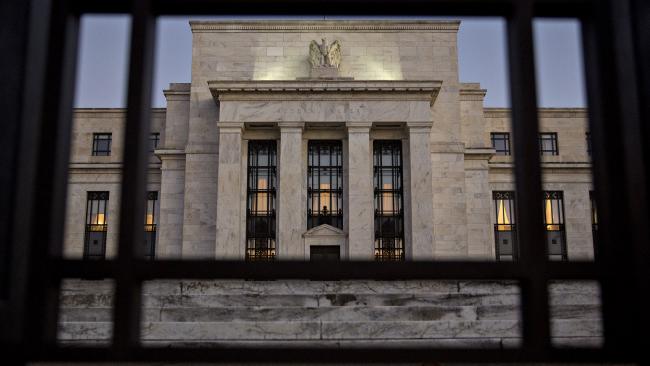(Bloomberg) -- Tougher Federal Reserve stress tests forced some of Wall Street’s top banks to rein in ambitious plans for pumping out cash to shareholders. But even those diminished returns spell a record payout to investors.
As the central bank’s annual stress tests ended Thursday, the nation’s four largest lenders -- JPMorgan Chase & Co (NYSE:JPM)., Bank of America Corp (NYSE:BAC)., Wells Fargo (NYSE:WFC) & Co. and Citigroup Inc (NYSE:C). -- said they will distribute more than $110 billion through dividends and stock buybacks, sending their stocks higher. Even shares of Goldman Sachs Group Inc (NYSE:GS). and Morgan Stanley (NYSE:MS) -- which the Fed blocked from boosting total payouts -- climbed in early trading Friday.
The Fed’s decisions in the test provided some relief for investors after a record 13 straight days of declines in the S&P 500 Financials Index. In the hours after clearing the test, more than 20 firms described how they’ll reward their owners over the coming four quarters. Wells Fargo plans to boost payouts more than 70 percent to about $33 billion, while JPMorgan signaled a 16 percent increase to $32 billion.
“Today is about the capital announcements, and what we’re seeing is dividends going up more than 30 percent on average,” said Marty Mosby, an analyst at Vining-Sparks IBG LP, as announcements were still rolling in. In addition, buybacks mean “share count is going to go down by about 6 to 7 percent,” boosting earnings per share, he said.
Wells Fargo rose 3.6 percent as of 7:02 a.m. in New York. JPMorgan and Citigroup both advanced at least 1.8 percent.
The Fed also delivered some bad news. The regulator said it rejected initial proposals from six firms -- JPMorgan, Goldman, Morgan Stanley, American Express Co (NYSE:AXP)., M&T Bank Corp (NYSE:MTB). and KeyCorp (NYSE:KEY) -- to make even higher payouts, forcing them to temper their requests. Never have so many firms taken that so-called mulligan to finish the exam.
Goldman passed after agreeing to make payouts in line with the average of the past two years. Morgan Stanley maintained the level it paid in the past 12 months. Those plans could still leave them short of regulatory minimums in a severe crisis, the Fed projected. But the regulator let them proceed after considering the impact of one-time charges in the fourth quarter linked to U.S. tax cuts -- which are expected to boost future profits.
That leniency contrasted with past years, said David Wright, managing director of Deloitte & Touche LLP’s banking and securities regulatory practice.
“They felt they could provide some accommodation to a small number of firms,” he said. “I wouldn’t expect this to have happened a few years ago under different leadership at the supervisory agencies.”
The Fed also failed a U.S. subsidiary of Deutsche Bank AG (DE:DBKGn), citing “widespread and critical deficiencies” in its planning. The widely anticipated rejection limits the unit’s ability to send capital home to Germany and comes as senior executives try to bolster investor confidence. The Frankfurt-based firm said it’s working with regulators and making progress.
The Fed said State Street Corp (NYSE:STT).’s plan was approved on the condition that the company improves its methodology on calculating counterparty exposures under stressed scenarios. The New York-based bank said it “took a conservative approach.”
Altogether, firms will distribute about 95 percent of their profits, the Fed projected, roughly in line with analysts’ estimates. That means that despite their stumbles in the tests, big banks may deliver the $170 billion in combined payouts that Wall Street analysts had predicted for the coming 12 months -- about $30 billion more than in the previous four quarters.
Analysts had anticipated some firms would probably struggle. Several estimated Morgan Stanley would increase its payout only slightly and that Goldman Sachs would return less cash. Further hints of trouble emerged last week, when the pair barely passed the test’s first round, based on continuing payouts at past levels. Shares of both companies were little changed in late trading Thursday.
The Fed’s hypothetical scenarios were much harsher this year, including a 65 percent drop in stock prices and a U.S. economic contraction of as much as 8.9 percent. The worst point in tests for the past three years didn’t exceed 7.5 percent. The scenarios created bigger theoretical losses for firms that have large capital markets businesses. Goldman and Morgan Stanley’s earnings rely more on trading and wealth management than bigger rivals who also do consumer and commercial banking.
The Fed proposed major revisions to its exam program in April, which will probably be finalized later this year and go into effect with next year’s test. Banks will no longer fail the quantitative portion, and the hypothetical drop in their capital levels under stress will become a conservation buffer that will be incorporated into their ongoing minimum capital requirements. They can still fail the qualitative portion, which only 18 of the 35 firms being tested are subject to.
(Updates share prices in second and fifth paragraphs.)
